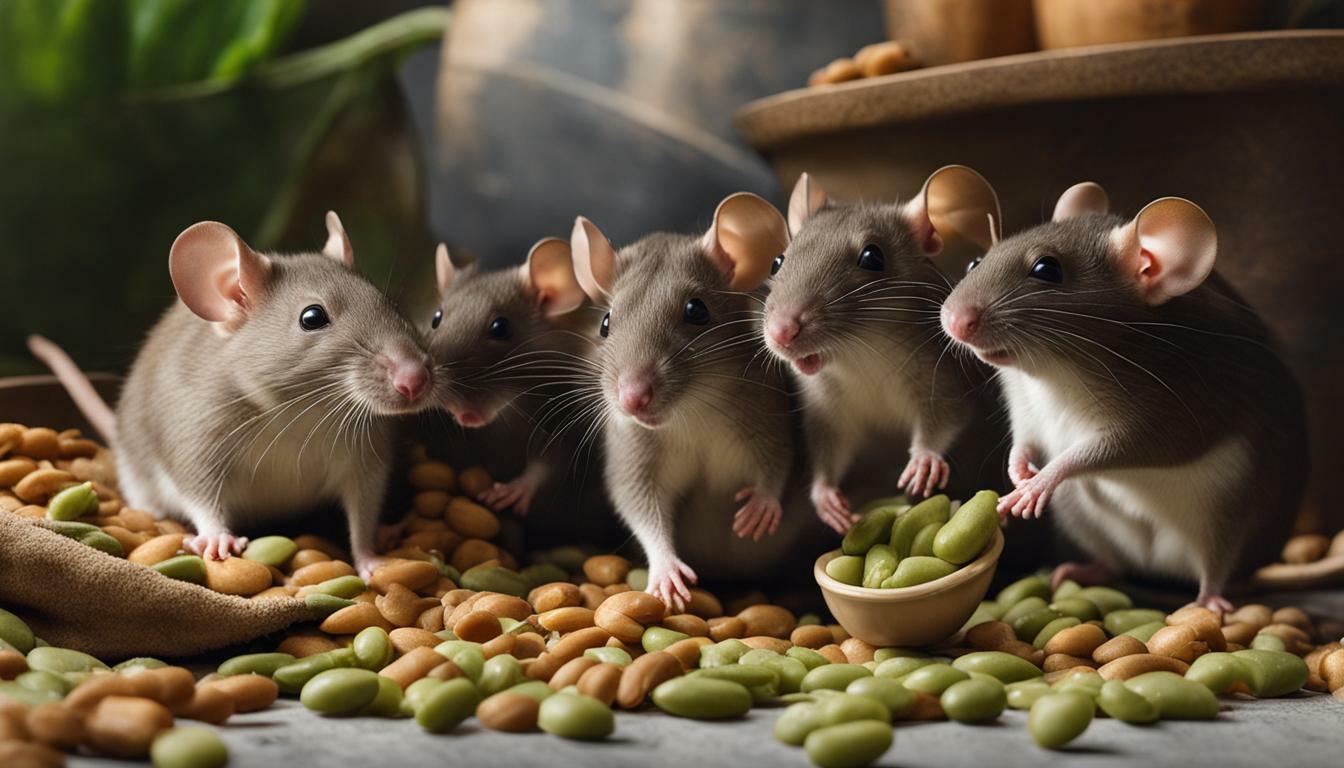If you’re wondering whether it’s safe to feed lima beans to your pet rat, we’ve got you covered with all the information you need.
Factual data: Lima beans, also known as butter beans, can be a nutritious treat for rats. They are a good source of protein, fiber, vitamins, and minerals. However, it is important to cook the beans thoroughly before feeding them to rats, as raw lima beans contain lectin, which can be toxic. Whole lima beans can also pose a choking hazard for smaller rats, so they can be mashed or chopped into smaller pieces. It is recommended to feed lima beans to rats in moderation, about one teaspoon per serving for adult rats, once or twice a week. If rats don’t enjoy lima beans or if you prefer alternatives, other healthy legumes and vegetables like green peas, chickpeas, lentils, sweet potatoes, carrots, broccoli, spinach, and bell peppers can be included in their diet. It is important to avoid feeding rats raw dry beans or peanuts, raw sweet potato, raw red cabbage and Brussels sprouts, raw artichokes, green bananas, green potato skin and eyes, wild insects, rhubarb, and orange juice (for male rats only). Always monitor rats’ health and consult a veterinarian if any changes or concerns arise.
Key Takeaways:
- Lima beans can be a nutritious treat for rats, providing protein, fiber, vitamins, and minerals.
- It is crucial to cook lima beans thoroughly before feeding them to rats, as raw beans contain lectin, which can be toxic.
- Smaller rats may have difficulty eating whole lima beans, so consider mashing or chopping them into smaller pieces.
- Feed lima beans to rats in moderation, about one teaspoon per serving for adult rats, once or twice a week.
- If rats don’t enjoy lima beans, you can offer other healthy legumes and vegetables as alternatives.
- Avoid feeding rats certain foods, including raw dry beans or peanuts, raw sweet potato, raw red cabbage and Brussels sprouts, raw artichokes, green bananas, green potato skin and eyes, wild insects, rhubarb, and orange juice (for male rats only).
- Monitor rats’ health and consult a veterinarian if any changes or concerns arise.
The Nutritional Benefits of Lima Beans for Rats
Lima beans, also known as butter beans, can provide several important nutritional benefits for rats. These small, green legumes are packed with protein, fiber, vitamins, and minerals that contribute to a healthy diet for your furry friend.
The protein content in lima beans is particularly beneficial for rats as it supports muscle growth and repair. Additionally, the fiber in these beans aids in digestion and helps maintain a healthy weight. The vitamins and minerals found in lima beans, such as vitamin C, vitamin K, iron, and manganese, are essential for various bodily functions and overall well-being.
To ensure the safety and maximum nutritional value of lima beans for rats, it is important to cook them thoroughly. Raw lima beans contain a compound called lectin, which can be toxic to rats. By cooking the beans, you eliminate this risk and make them safe for consumption.
When feeding lima beans to rats, it’s worth noting that whole beans can pose a choking hazard, especially for smaller rats. To prevent any potential issues, you can mash or chop the beans into smaller, more manageable pieces. It’s also recommended to feed lima beans to rats in moderation, about one teaspoon per serving for adult rats, once or twice a week.
Table: Nutritional Content of Lima Beans (per 100g)
| Nutrient | Amount |
|---|---|
| Protein | 7.8g |
| Fiber | 7.8g |
| Vitamin C | 5.1mg |
| Vitamin K | 2.8mcg |
| Iron | 1.8mg |
| Manganese | 0.4mg |
If your rats don’t particularly enjoy lima beans or if you prefer to offer them a variety of foods, there are alternative legumes and vegetables that can be included in their diet. Green peas, chickpeas, lentils, sweet potatoes, carrots, broccoli, spinach, and bell peppers are all healthy options that offer nutritional benefits similar to lima beans.
Remember to avoid feeding rats certain foods that can be harmful to their health. This includes raw dry beans or peanuts, raw sweet potato, raw red cabbage and Brussels sprouts, raw artichokes, green bananas, green potato skin and eyes, wild insects, rhubarb, and orange juice (for male rats only). Monitoring your rats’ health and consulting a veterinarian if you notice any changes or concerns is always a wise decision.
Preparing Lima Beans for Rats
Before offering lima beans to your rat, it’s essential to take the necessary steps to prepare them. Raw lima beans contain lectin, a substance that can be toxic to rats. Therefore, cooking the beans thoroughly is crucial to ensure their safety. Here’s a simple guide to properly prepare lima beans for your furry friend:
- Start by rinsing the lima beans under cold water to remove any dirt or debris.
- Next, place the beans in a pot and cover them with water. Bring the water to a boil and let the beans simmer for about 45 minutes to an hour, or until they are soft and tender.
- Once the beans are cooked, drain the water and let them cool down. It’s important to let them cool completely before offering them to your rat to avoid any burns or discomfort.
- You can then choose to mash or chop the lima beans into smaller pieces, especially if you have smaller rats that might struggle with whole beans or if you want to mix them with other foods.
Remember, moderation is key when it comes to feeding lima beans to rats. Offering about one teaspoon per serving for adult rats, once or twice a week, is a good guideline to follow. Additionally, always monitor your rat’s reaction to lima beans and ensure they are enjoying them. If they don’t seem interested or prefer alternatives, such as green peas, chickpeas, lentils, sweet potatoes, carrots, broccoli, spinach, and bell peppers, you can provide those instead to ensure a balanced and varied diet.
It’s also essential to be aware of foods that are toxic or potentially hazardous to rats. Besides raw lima beans, you should avoid feeding your rat raw dry beans or peanuts, raw sweet potato, raw red cabbage and Brussels sprouts, raw artichokes, green bananas, green potato skin and eyes, wild insects, rhubarb, and orange juice (for male rats only). These foods can pose risks to your rat’s health and should be excluded from their diet.
Always keep a close eye on your rat’s health and behavior. If you notice any changes or have concerns about their well-being, don’t hesitate to consult a veterinarian who can provide expert advice and guidance tailored to your rat’s specific needs. By taking these precautions and providing a balanced diet, you can ensure the health and happiness of your furry friend.
| Lima Beans Preparing Steps |
|---|
| Rinse the lima beans under cold water. |
| Cover the beans with water, boil, and simmer for 45 minutes to an hour. |
| Drain and let the beans cool down. |
| Mash or chop the lima beans into smaller pieces if desired. |
Serving Size and Frequency for Lima Beans
While lima beans can be a healthy addition to a rat’s diet, it’s important to ensure the right amount and frequency of feeding them. Rats have specific dietary needs, and it’s crucial to provide them with a balanced and varied diet.
The recommended serving size of lima beans for adult rats is about one teaspoon per serving. This portion is suitable for most rats and helps prevent overfeeding, which can lead to obesity and other health issues. It’s best to offer lima beans to rats once or twice a week, alongside their regular diet of rat pellets, fresh fruits, and vegetables.
For smaller rats or rats with dental issues, whole lima beans can pose a choking hazard. In these cases, you can mash or chop the beans into smaller pieces to make them easier to eat. Ensuring the beans are properly cooked is essential, as raw lima beans contain a substance called lectin, which can be toxic to rats. Cooking the beans thoroughly eliminates this risk and ensures their safety for your furry friends.
| Rat Size | Serving Size | Frequency |
|---|---|---|
| Adult Rats | 1 teaspoon | Once or twice a week |
| Smaller Rats or Rats with Dental Issues | Mashed or chopped into smaller pieces | Once or twice a week |
If your rats don’t particularly enjoy lima beans or if you prefer to provide them with alternative options, there are several other healthy legumes and vegetables you can incorporate into their diet. Green peas, chickpeas, lentils, sweet potatoes, carrots, broccoli, spinach, and bell peppers are all nutritious choices that can provide your rats with a varied and well-rounded meal plan.
However, it’s important to remember that not all foods are safe for rats. Avoid feeding them raw dry beans or peanuts, raw sweet potato, raw red cabbage and Brussels sprouts, raw artichokes, green bananas, green potato skin and eyes, wild insects, rhubarb, and orange juice (for male rats only). These foods can be harmful to their health and should be avoided.
Always keep a close eye on your rats’ health and wellbeing. Monitor their eating habits, weight, and overall behavior. If you notice any changes or have concerns, it’s best to consult a veterinarian who specializes in small animals. They can provide guidance and ensure your rats are receiving the proper care and nutrition they need to thrive.
Alternatives to Lima Beans for Rat Nutrition
If your rat doesn’t enjoy lima beans or if you’re looking to diversify their diet, there are several other healthy options to consider. These alternatives can provide a range of nutrients and flavors to help keep your rat happy and healthy.
Legumes:
Legumes are a great source of protein and fiber, making them an excellent addition to a rat’s diet. Green peas, chickpeas, and lentils are all nutritious options that rats tend to enjoy. These legumes can be cooked and served to rats in small portions, providing an extra boost of nutrients.
Vegetables:
Incorporating a variety of vegetables can help ensure that your rat receives a well-rounded diet. Sweet potatoes, carrots, broccoli, spinach, and bell peppers are all rich in vitamins and minerals that can support your rat’s overall health. These vegetables can be steamed or cooked to make them easier for rats to chew and digest.
It is important to avoid certain foods that can be harmful to rats, such as raw dry beans or peanuts, raw sweet potato, raw red cabbage and Brussels sprouts, raw artichokes, green bananas, green potato skin and eyes, wild insects, rhubarb, and orange juice (for male rats only). Always be mindful of what you offer your rat and choose safe, rat-friendly options.
Remember to offer alternatives gradually, and observe your rat’s response to ensure they enjoy their new additions. Together with lima beans or as standalone treats, these alternatives can help provide a balanced and diverse diet for your furry friend.
| Legumes | Vegetables |
|---|---|
| Green peas | Sweet potatoes |
| Chickpeas | Carrots |
| Lentils | Broccoli |
| Spinach | |
| Bell peppers |
Rats and Foods to Avoid
While there are many foods that rats can safely consume, it’s important to be aware of the ones that can be harmful to their health. As a responsible rat owner, you want to provide a nutritious and safe diet for your furry friends. Here is a list of foods that you should avoid feeding rats:
- Raw dry beans or peanuts: Raw dry beans and peanuts contain harmful lectins and anti-nutrients that can be toxic to rats.
- Raw sweet potato: Raw sweet potato can cause digestive issues and should be cooked thoroughly before feeding to rats.
- Raw red cabbage and Brussels sprouts: These vegetables can cause gas and bloating in rats when consumed raw. Cooking them can help mitigate these effects.
- Raw artichokes: Raw artichokes contain compounds that can be toxic to rats and should be avoided.
- Green bananas: Unripe green bananas are difficult to digest and can cause stomach discomfort for rats. Stick to ripe bananas as an occasional treat.
- Green potato skin and eyes: The green parts of potatoes contain solanine, which is toxic to rats. Always remove the skin and eyes before feeding potatoes to your rats.
- Wild insects: While rats are known to be resourceful foragers, it’s important to avoid feeding them wild insects, as they may carry diseases or be exposed to harmful pesticides.
- Rhubarb: Rhubarb leaves and stems contain high levels of oxalic acid, which can be toxic to rats. Avoid feeding them any part of the rhubarb plant.
- Orange juice (for male rats only): Citrus fruits like oranges and their juices can disrupt the digestive system of male rats. It’s best to avoid offering them orange juice.
By avoiding these foods, you can help ensure the health and well-being of your rat companions. Remember to always monitor their health and consult a veterinarian if you have any concerns or notice any changes in their behavior or appetite. Your veterinarian can provide guidance on the best diet and nutrition for your rats, as well as address any specific dietary restrictions or concerns.
| Foods to Avoid | Reasons to Avoid |
|---|---|
| Raw dry beans or peanuts | Contain toxic lectins and anti-nutrients |
| Raw sweet potato | Can cause digestive issues |
| Raw red cabbage and Brussels sprouts | Can cause gas and bloating |
| Raw artichokes | Contain toxic compounds |
| Green bananas | Difficult to digest and can cause stomach discomfort |
| Green potato skin and eyes | Contain solanine, which is toxic |
| Wild insects | Potential exposure to diseases and pesticides |
| Rhubarb | High levels of oxalic acid, toxic to rats |
| Orange juice (for male rats only) | Can disrupt the digestive system |
Monitoring Rat Health and Seeking Veterinary Advice
Keeping a close eye on your rat’s health and seeking professional advice when needed is crucial for their overall well-being. Rats, like any other pets, can experience health issues that may require prompt attention. By being vigilant and proactive, you can ensure that your furry friend receives the necessary care and treatment.
Regularly monitor your rat for any changes in behavior, appetite, or physical appearance. A sudden loss of appetite, weight loss, lethargy, or changes in urine or stool can be signs of underlying health problems. In case you notice any unusual symptoms, it is advisable to consult a qualified veterinarian who specializes in small animals or exotic pets.
“As a rat owner, you play a crucial role in preventing and managing health issues. Make sure to provide your rat with a clean and safe living environment, a balanced diet, and plenty of mental and physical stimulation.”
In addition to regular check-ups, it is important to establish a good relationship with a trusted veterinarian who has experience with rats. They can provide guidance on proper nutrition, preventative care, and offer valuable advice tailored to your rat’s specific needs. Regular veterinary visits can help detect and address potential health concerns early on, ensuring the best possible outcome for your pet.
| Common Rat Health Issues | Signs to Watch for | Action to Take |
|---|---|---|
| Respiratory Infections | Sneezing, wheezing, labored breathing, nasal discharge | Contact a veterinarian immediately for diagnosis and treatment |
| Tumor Development | Visible lumps or bumps on the rat’s body | Consult a veterinarian for evaluation and potential surgical removal |
| Dental Issues | Difficulty eating, drooling, overgrown or misaligned teeth | Seek veterinary care to address dental problems and provide appropriate treatment |
| Parasites | Excessive scratching, scabs, hair loss, visible insects or eggs | Consult a veterinarian for suitable parasite treatment options |
Remember, prevention is better than cure. By providing your rat with a healthy diet, clean environment, and regular veterinary care, you can significantly reduce the likelihood of health issues arising. Stay attentive to your rat’s well-being and cherish the precious moments you share together.
Conclusion
In conclusion, lima beans can be a nutritious addition to a rat’s diet when prepared properly and offered in appropriate amounts. These beans, also known as butter beans, are packed with protein, fiber, vitamins, and minerals, making them a healthy treat for rats. However, it’s crucial to cook the beans thoroughly before feeding them to your furry friends. Raw lima beans contain a toxin called lectin, which can be harmful to rats. So, always ensure that the beans are cooked to eliminate any potential toxicity.
When serving lima beans to rats, it’s important to consider their size. Whole lima beans can pose a choking hazard for smaller rats, so it’s recommended to mash or chop them into smaller pieces. As for the serving size, adult rats can be given about one teaspoon of lima beans per serving, once or twice a week. Remember to offer lima beans in moderation, as part of a balanced diet.
If your rats don’t particularly enjoy lima beans or if you prefer to diversify their diet, there are other healthy legumes and vegetables that can be included in their meals. Consider options like green peas, chickpeas, lentils, sweet potatoes, carrots, broccoli, spinach, and bell peppers. These alternatives can provide a variety of nutrients and help ensure a well-rounded diet for your rats.
On the other hand, there are certain foods that should be avoided when feeding rats. Raw dry beans or peanuts, raw sweet potato, raw red cabbage and Brussels sprouts, raw artichokes, green bananas, green potato skin and eyes, wild insects, rhubarb, and orange juice (for male rats only) are all on the list of foods to steer clear of. As responsible rat owners, it’s important to monitor your rats’ health and seek veterinary advice if any changes or concerns arise.
FAQ
Can rats safely eat lima beans?
Yes, rats can eat lima beans. However, it is important to cook them thoroughly before feeding them to rats to ensure their safety. Raw lima beans contain lectin, which can be toxic to rats.
What are the nutritional benefits of lima beans for rats?
Lima beans are a good source of protein, fiber, vitamins, and minerals, making them a nutritious addition to a rat’s diet. They can contribute to a well-rounded and healthy diet for rats.
How should I prepare lima beans before feeding them to rats?
Lima beans should be cooked thoroughly before giving them to rats. This helps remove any potential toxins and ensures their safety. Raw lima beans should not be fed to rats.
How much and how often can rats eat lima beans?
It is recommended to feed rats lima beans in moderation. For adult rats, about one teaspoon per serving, once or twice a week, is a suitable amount. This helps maintain a varied diet for rats.
Can I offer alternatives to lima beans for my rats?
Yes, if your rats don’t enjoy lima beans or if you prefer alternatives, there are other healthy legumes and vegetables you can include in their diet. Some options include green peas, chickpeas, lentils, sweet potatoes, carrots, broccoli, spinach, and bell peppers.
Are there any foods that rats should avoid?
Yes, there are certain foods that rats should avoid. These include raw dry beans or peanuts, raw sweet potato, raw red cabbage and Brussels sprouts, raw artichokes, green bananas, green potato skin and eyes, wild insects, rhubarb, and orange juice (for male rats only).
How can I monitor the health of my rats and when should I seek veterinary advice?
It is important to monitor your rats’ health regularly. If you notice any changes or have concerns, it is recommended to consult a veterinarian. Regular check-ups and attentive observation can help catch any potential health issues early on.




